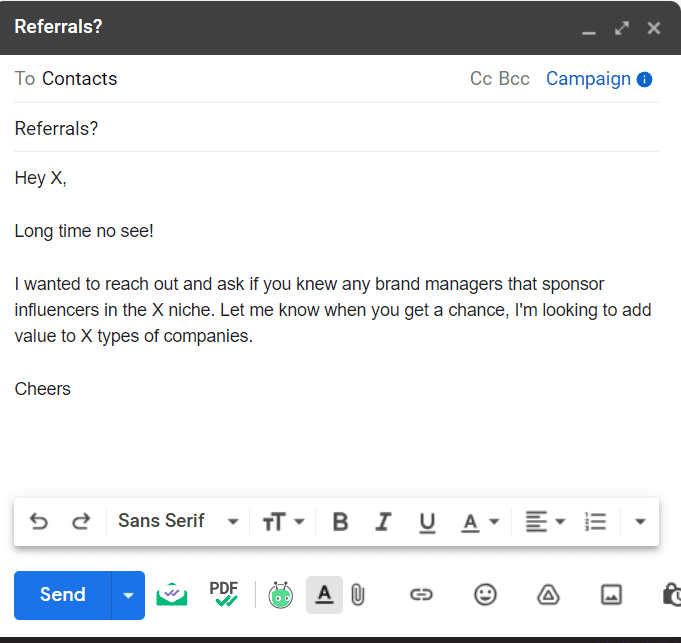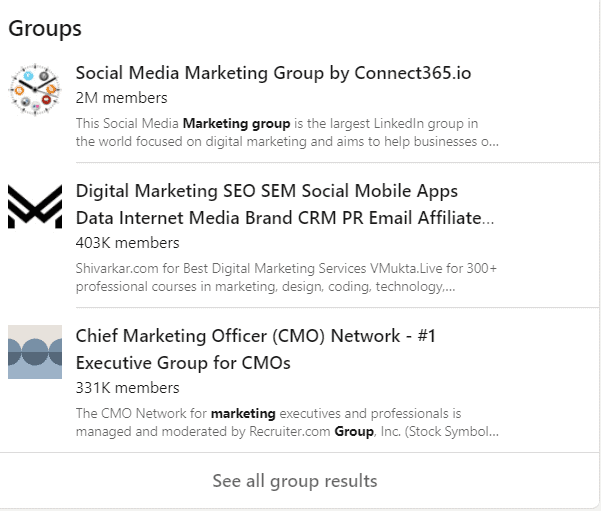Brand sponsorships are one of the primary revenue-generating opportunities for influencers. Influencers of all sizes dream of reaching out to their favorite brands and landing long-lasting, fruitful partnerships. Although most influencers hope to land brand sponsorships, they fail to do so because they don’t know how to reach out to brands and negotiate deals.
Reaching out to brands entails several key steps. If you fail to do any single step, it can result in the brand not seeing or rejecting your sponsorship proposal. In this post, we’ll cover exactly how to reach out to brands as an influencer and maximize your chances of getting a favorable brand deal. This includes doing research, creating a strong pitch, using email marketing and leveraging your existing network.

Do market research
One of the most common mistakes that influencers make when reaching out to brands is that they don’t do enough market research. Market research consists of two parts: understanding the brands that you want to work with and understanding the value you can bring them.
When it comes to brands, you should take the time to research the brands that you want to work with. This means more than just looking at their Instagram feed and knowing their general aesthetic. You should also be familiar with their target audience, the type of content they usually post, the influencers they’ve worked with in the past, and their social media presence. This research will help you create a targeted pitch that is more likely to resonate with the brand.
You can do even further market research by looking at if the brand uses paid ads, SEO, social media marketing or other forms of online advertising. This will help you get a sense for their advertising budget and you can use this information to negotiate your rate. For example, if you look at paid ads on Google, you can estimate the cost per click of different keywords the brand is advertising for. You can use this information to price the cost per click you provide for the brand.
Similarly, you should also research your own value as an influencer. This includes understanding your audience, your reach, your engagement rate, and the type of content you produce. All of this information will help you understand how much brands are willing to pay. By having this type of data at your disposal, you can tangibly illustrate the value you can bring to them and negotiate a better rate for your deal.
Finding the right contact
After you’ve done some market research, it’s time to find the right contact to send your pitch to. This is an extremely important step because if you don’t get the contact information right, your pitch will likely never be seen by the right person. There’s no point in doing all of the work for market research if your pitch won’t even reach the right contact.
A great way to find the right contact for your brand outreach is to use LinkedIn. On LinkedIn, you can search the company name and get access to the different employees that work there. Once you land on the company page, you can search by department, name, etc. to find the right person to contact.
The person you’re looking for will have a different title depending on the company. Some titles you can look up on LinkedIn to find the right contact include:
- Social media manager
- Brand partnerships manager
- Director of content
When you find the right person to contact, be sure to include their name and some information about them so that the recipient knows you’ve done your research. This small addition can make a big difference and show that you’re serious about working with the brand. Brands get hundreds of emails per day; doing this can help you stand out and land you the deal you want. After you’ve found the right contact, you can use cold calling tools or cold email software like SmartReach.io to get in touch with your person of interest.

Ask for referrals
A great way to start your brand deal with leverage is to get a referral from a mutual contact. You can reach out to former clients, contacts in your industry and your colleagues to ask for a referral to companies you want to partner with. When you do this, you start the relationship with a foot in the door, which can make it easier to land a deal.
A referral also goes a long way in building your credibility with brands. Having someone vouch for you will show brands that you’re someone they can trust and that you have a proven track record of producing quality content. This can help brands feel more confident in working with you, which can lead to a larger budget for your deal.
To get referrals, start by reaching out to your network and asking if they know anyone who works at the brands you’re interested in. If they don’t have a specific person in mind, ask them if they would be willing to introduce you to someone at the company.
When you have a referral, make sure to mention it in your initial pitch to the brand. This will show that you have a connection at the company and that you’re serious about working with them. The brand manager can then easily verify you’re a legitimate influencer who can bring brand awareness, clicks and sales for their business.
An advanced referral strategy you can deploy includes providing your contact with an affiliate commission. This means that if the brands you refer to work with you and pay you for your content, your contact will also receive a commission. This is a great way to incentivize people to help you land brand deals and can help you get in front of more brands. By starting your own mini-affiliate program, you increase the amount of leads you have and you can ensure your deal pipeline is full.
Refining your email copy
Now that you have the right contact, it’s time to craft the best email to convince the brand manager that you’re the right partner for their business. Your email copy consists of two major components: the subject and email body.
The subject line of your email is the first thing that the brands will see when they open your email. It’s important to make sure that your subject line is clear, concise, and to the point. It should be something that catches the brand’s attention and makes them want to read more. The better your subject line is, the better the chance of your email being read. Something brand-specific and catchy would be ideal.
In addition to having one of the best subject lines for cold emails, you need a well-crafted email. This includes a great opening, demonstrating why you’re a good fit for the brands, and a call-to-action. To maximize the efficiency of your email copy, you should have a good offer that aligns with the brand. This could be in the form of a free value-add, an exclusive offer, or something else that would be appealing to the brands.
Following up with emails
Even with great market research, a well-crafted email, and the perfect offer, brands can still be slow to respond. In this case, it’s important to follow up with brands. Following up shows that you’re committed to working with the brands and that you’re serious about the offer you made. The majority of successful email campaigns require at least 1-2 follow-ups before the prospect replies and gives you a response on your pitch.
When following up with brands, make sure not to come across as too pushy. You want to show that you’re interested in working with them, but you don’t want to be a nuisance. The best way to do this is to space out your follow-up emails. I would recommend waiting at least 3-5 days in between each follow-up email and you should have 3-4 follow-up emails total. This gives them enough time to respond and if they don’t by the last follow-up, you can focus on your next prospect.
What should you do if your outreach doesn’t work?
Oftentimes, cold outreach to brands may not work on the first try. Although you can analyze what went wrong in your outreach, there are still actionable steps you can take to land your next brand sponsor. You can focus on continuing to create content, building your brand network and getting inbound inquiries for brand partnerships. This is often the best way to get brand sponsorships because brands are genuinely interested in working with you. Some steps you can take right now to get more inbound brand deals include:

Building rapport and relationships within your industry
Establishing your brand in your industry is a great way to get brands to come to you. When brands see that you’re an expert in your field, they’ll be more likely to want to work with you because they know that you can provide value to their business.
Some ways to do this include writing blog posts, guest blogging, being active on social media, and networking at industry events. As you build your brand presence, you’ll start to get more inbound inquiries from brands that want to work with you.
Tobias Biberbach, director at Split My Fare, recommends leveraging both online platforms and in-person events to build rapport and relationships within your industry. This will help break the ice and help you warm up leads prior to engaging with them for any sponsored content.
Creating content that brands want to sponsor
One of the best ways to attract brand partnerships is to create content that brands want to promote. This could be in the form of blog posts, social media posts, or even videos. When brands see that you’re creating content that’s relevant to their business, they’ll be more likely to want to work with you.
To create content that brands want to sponsor, start by identifying the topics that are most relevant to the brands you want to work with. Once you have a good understanding of the topics they’re interested in, you can start creating content around those topics. Along with this, it’s beneficial to have a content strategy for SEO to grab the attention of brands.
If you’re not sure where to start, reach out to brands and ask them what type of content they would be interested in sponsoring. This will give you a good idea of the types of content that brands are looking for. For example, if you’re looking to work with an ecommerce company like Shopify or BigCommerce, you can create content on sourcing products, selling on their platform, etc. These kinds of content are extremely relevant to a company like Shopify and they’re much more willing to endorse that type of content.
Adding value to brands
One of the best ways to fill up your sponsorship pipeline with deals is to add value to brands prior to engaging with them. This doesn’t necessarily mean give them free and unlimited promo, you can still be strategic about it. Some brands may want you to give them a shoutout on social media, write a review of their product, or mention them in your blog post. For example if you want an affiliate sponsorship for a MSP software product, include the companies you want to work with in your round-up post. This makes it much easier to reach out to them and land a deal.
Whatever the case may be, make sure that you’re only doing this for brands that you genuinely want to work with. This should be for brands that pay well and brands that you’re proud to work with. The better the brands you work with, the higher the bar will be for the next sponsorship.
Another way to add value to brands is to mention them in your content. This could be in the form of a blog post, social media post, or even a video. When you mention brands in your content, it helps to increase their visibility and reach. As a result, they’re more likely to want to work with you because you’re providing them with valuable exposure. You can also use this when you’re reaching out to them. You can have a subject line like “You’re featured in X magazine/blog/account”. This shows the brand you’ve already taken the initiative and you are interested in working with them.
Using these strategies like adding value to a brand and building relationships in your industry is a great way to fill your sales pipeline in the long run. By combining your outreach efforts with these inbound tactics, you’ll be able to create a strong sponsorship program that consistently brings in deals.


